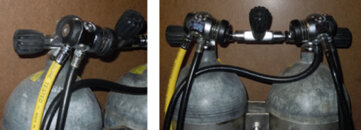I used to use Mk 20s and Mk 25s in very cold water. The Mk 20 was the immediate predecessor of the Mk 25, and the first Mk 25 was just a Mk 20 with an adjustable seat retainer.
The Mk 20s and 25s from that era (and the slightly earlier Mk 15s) could use a SPEC boot that fit over the first stage from the trim boot back over the ambient pressure chamber holes. It was a development of the smaller, thicker SPEC boot used on the late production MK 10 and Mk 10 Plus first stages, but it was larger and flexible so it allowed for the displacement of the silicone in the chamber as the piston cycled.
SPEC stood for Silicone Protected Environmental Chamber and it involved packing the ambient chamber with silicone to prevent the intrusion of water. That in turn prevented the formation of ice on the spring, the piston stem, or on the surfaces just below the piston head, which could cause the piston to stick open and cause a free flow.
Properly packed, the SPEC system did a very good job at freeze protection. The problem was that you had to pack the environmental chamber ad spring properly for it to work reliably, and to prevent trapping salt water against metal parts and causing corrosion. Way too many tech just squirted silicone grease through the ambient chamber holes and called it good.
A new problem resulted when Nitrox came on the scene with an initial obsession with "O2 clean" and a move away from environmental silicone. Christolube would still work in a SPEC system, but you needed about $30 worth of it to pack the chamber, and it was less viscous so it tended to leak out sooner.
As a result, Scubapro did away with the SPEC boots during Mk 20 production. Instead they used their "TIS" system, which stands for thermal insulating system. Initially Scubapro enlarged the ambient pressure holes in the swivel cap, from small round holes, to large round holes, then to large oval holes to increase heat transfer by increasing water flow through the ambient chamber. Eventually the swivel cap was changed in the middle of Mk 25 production to accommodate fins that increase heat transfer and on those regs SPEC boots can not be used.
There have been numerous "improvements" in the Mk 25 TIS system over the years, primarily because it's never worked all that well in water colder than about 40 degrees. The latest iteration is the Mk 25 EVO and Scubapro claims it is both 40% more effective than the old TIS system, and as reliable as the sealed Mk 17 in laboratory testing. Given the claims Scubapro has made for the TIS system over the years, I've very skeptical, and I'm also painfully aware that reliability in lab testing is no where near the same as reliability in real world conditions.
Eventually I dumped the Mk 20 and Mk 25, and went with the Mk 17 for deep technical diving with bottom temps below 40 degrees. The Mk 17 is fully sealed and is virtually bullet proof in cold water diving. If you let it free flow an entire set of doubles at depth, in very cold water, you'll eventually get a ball of ice around the reg that could conceivably keep the external diaphragm and the pressure transmitter depressed and cause a freeze flow, or you could have inadequately dried gas in the tanks that could cause internal parts to freeze up, so I won't say it's impossible to freeze one up - but you'd really have to work hard at it. I can't come anywhere close to saying that about a Mk 25.
Consequently, my advice for cold water technical diving is to get a Mk 17. It'll flow around 240 cu ft per minute which while less than the 300 a Mk 25 will flow, is still over lill and way more than you need even for deep technical diving. The Mk 17 EVO adds 2 more high flow ports (all of them) and adds a little more flow rate, which is just more overkill for an already great reg.
-----
The S600 has it's own issues in cold water. The plastic air barrel in the S600 limited heat transfer and in very cold water the orifice, and valve parts in the vicinity would get very cold. If any water entered the second stage, it could freeze on contact and prevent the valve from closing. A slight free flow would result and a large freeze flow would quickly develop. A plastic orifice helped a bit by shedding ice better, but the ultimate solution was a metal orifice with a metal air barrel. The metal air barrel had been used on the earlier G500 and was re-released in some S600s, and it has the side benefits of preventing cracking in the air barrel and in reducing dry mouth. If you have an S600 and you dive in very cold water, a metal air barrel is worth getting.
The G250, G250V and current G260 all use a metal air barrel that has the added advantage of sticking out both sides of the cases with a finned inlet fitting nut and a finned adjustment knob that both facilitate heat transfer. They are much more reliable in cold water, and the greater weight from all that metal is offset by greater buoyancy.
----
Regardless of what you have, removing the hose protectors and trim boots will increase the area exposed to water and will increase the heat transfer, giving you more of a margin against freezing on a cold water dive. The increased area of the metal hose fitting on the HP and LP hoses is significant and makes a noticeable difference once you remove those totally useless hose protectors.





